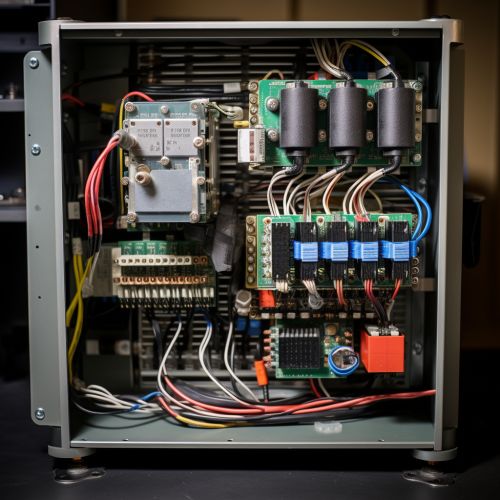Power supply unit
Overview
A power supply unit (PSU) is an essential component of most electronic devices, converting power from a source such as the electrical grid into a form that the device can use. The PSU typically converts alternating current (AC) from the power grid into direct current (DC) for use by the device. The PSU also regulates the voltage to an appropriate level for the device. The specific requirements for power and voltage vary widely among different devices, and thus PSUs come in many different forms and sizes.


Function
The primary function of a PSU is to convert the AC power from the mains (electric power grid) into DC power for the electronic device. This involves several steps. First, the PSU uses a transformer to step down the high voltage AC power from the mains to a lower voltage. Next, the PSU uses a rectifier to convert the AC power to DC power. Finally, the PSU uses a regulator to ensure that the output voltage is stable and within the tolerances required by the device.
The PSU also provides a number of other functions. It provides protection against power surges and voltage spikes that could damage the device. It also filters out noise and interference from the power line. In addition, the PSU often provides a way to turn the device on and off, either through a physical switch or through a signal from the device's control system.
Types of Power Supply Units
There are several different types of PSUs, each designed for specific types of devices and applications. These include:
- Switching Power Supplies: These are the most common type of PSU in modern electronic devices. They use a high-frequency switch to convert the AC power to DC power. This allows them to be much smaller and more efficient than other types of PSUs.
- Linear Power Supplies: These are a older type of PSU that use a transformer to step down the voltage and a rectifier to convert the AC power to DC power. They are larger and less efficient than switching power supplies, but they produce very clean and stable power, making them ideal for sensitive electronic devices such as audio equipment.
- Uninterruptible Power Supplies (UPS): These are a special type of PSU that includes a battery. They provide power to the device even if the mains power is interrupted, making them essential for critical systems such as servers and medical equipment.
- Programmable Power Supplies: These are a type of PSU that can be programmed to output different voltages and currents. They are used in research and development, as well as in manufacturing and testing of electronic devices.
- DC Power Supplies: These are a type of PSU that convert one level of DC voltage to another level. They are used in devices that are powered by batteries or other DC sources.
Design and Construction
The design and construction of a PSU depends on its type and its intended application. However, most PSUs have several common components. These include a transformer, a rectifier, a regulator, and a filter. The transformer steps down the voltage from the mains, the rectifier converts the AC power to DC power, the regulator ensures that the output voltage is stable, and the filter removes noise and interference.
The PSU also includes various safety features. These include a fuse or circuit breaker to protect against overcurrent, a surge protector to protect against voltage spikes, and an isolation transformer to protect against electric shock.
Applications
PSUs are used in a wide variety of electronic devices. These include computers, televisions, game consoles, servers, medical equipment, industrial machinery, and many others. The specific requirements for the PSU depend on the device. For example, a computer PSU needs to provide several different voltages for the various components, while a television PSU needs to provide a high voltage for the display.
